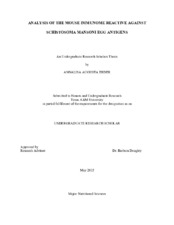| dc.creator | Erder, Annalisa Augusta | |
| dc.date.accessioned | 2015-06-30T14:02:30Z | |
| dc.date.available | 2015-06-30T14:02:30Z | |
| dc.date.created | 2015-05 | |
| dc.date.issued | 2014-09-12 | |
| dc.date.submitted | May 2015 | |
| dc.identifier.uri | https://hdl.handle.net/1969.1/154489 | |
| dc.description.abstract | Schistosomiasis is a waterborne parasitic infection affecting more than two hundred million people in the tropical and subtropical regions of the world. Currently, the disease is treated with the drug Praziquantel, but reinfection is common. If an anti-pathology vaccine were created, the rate of infection and reinfection of schistosomiasis would be significantly reduced. Humans with asymptomatic intestinal schistosomiasis and mice with moderate splenomegaly syndrome (MSS) share certain cross-reactive idiotypes (CRI), which are absent in the anti-egg antigen specific antibody responses of symptomatic hepatosplenic patients and mice with hypersplenomegaly syndrome (HSS). We hypothesize that CRI unique to MSS down-regulate the progress of the disease, while CRI unique to HSS may be pro-inflammatory. Therefore, identifying the proteins unique to each disease state could be used to produce a vaccine. CBA/J male mice with twenty-week infections develop the full chronic disease as seen in humans. Predictably 10 - 20% of infected mice will develop severe HSS. In order to identify all soluble proteins from schistosome egg antigens (SEA), proteins were separated based on size, pH, and pI by two-dimensional electrophoresis. Then unique antigen reactivity of the CRI was detected by Western blotting. To identify the antigens, the stains were compared to an SEA Proteomic map generated in The Center for Biodiscovery and Proteomics, University of Wellington, New Zealand, where protein analysis was completed via Matrix-Assisted Laser Desorption/Ionization – Time of Flight (MADLI-TOF) mass spectrometry. Results indicate that, while an estimate of thirty antigens are represented in both disease states, there are a few differences. Three antigens have been identified as unique to MSS: Calreticulum precursor, Calreticulum, and SJCHGCO1881 protein. Two antigens unique to HSS are Enolase (2phosphoglycerate dehydratase) and one unidentified protein. Future research would investigate the effectiveness of these antigens as anti-pathology vaccines, perhaps by using those only unique to MSS to promote down-regulation. | en |
| dc.format.mimetype | application/pdf | |
| dc.subject | schistosomiasis, immunology, biology, parasite, parasitology, waterborne, freshwater, illness, disease, pathology, vaccination | en |
| dc.title | Analysis of the Mouse Immunome Reactive against Schistosoma mansoni Egg Antigens | en |
| dc.type | Thesis | en |
| thesis.degree.department | Nutrition and Food Science | en |
| thesis.degree.discipline | Nutrition | en |
| thesis.degree.grantor | Honors and Undergraduate Research | en |
| dc.contributor.committeeMember | Doughty, Barbara | |
| dc.type.material | text | en |
| dc.date.updated | 2015-06-30T14:02:30Z | |


